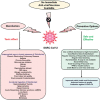Environmental and health impacts of spraying COVID-19 disinfectants with associated challenges
- PMID: 34599438
- PMCID: PMC8486161
- DOI: 10.1007/s11356-021-16575-7
Environmental and health impacts of spraying COVID-19 disinfectants with associated challenges
Abstract
Coronavirus refers to a group of widespread viruses. The name refers to the specific morphology of these viruses because their spikes look like a crown under an electron microscope. The outbreak of coronavirus disease 2019 (COVID-19) that has been reported in Wuhan, China, in December 2019, was proclaimed an international public health emergency (PHEIC) on 30 January 2020, and on 11 March 2020, it was declared as a pandemic (World Health Organization 2020). The official name of the virus was declared by the WHO as "COVID-19 virus", formerly known as "2019-nCoV", or "Wuhan Coronavirus". The International Committee on Virus Taxonomy's Coronavirus Research Group has identified that this virus is a form of coronavirus that caused a severe outbreak of acute respiratory syndrome in 2002-2003 (SARS). As a result, the latest severe acute respiratory syndrome has been classified as a corona virus 2 (SARS-CoV-2) pathogen by this committee. This disease spread quickly across the country and the world within the first 3 months of the outbreak and became a global pandemic. To stop COVID-19 from spreading, the governing agencies used various chemicals to disinfect different commercial spaces, streets and highways. However, people used it aggressively because of panic conditions, anxiety and unconsciousness, which can have a detrimental impact on human health and the environment. Our water bodies, soil and air have been polluted by disinfectants, forming secondary products that can be poisonous and mutagenic. In the prevention and spread of COVID-19, disinfection is crucial, but disinfection should be carried out with sufficient precautions to minimize exposure to harmful by-products. In addition, to prevent inhalation, adequate personal protective equipment should be worn and chemical usage, concentrations, ventilation in the room and application techniques should be carefully considered. In the USA, 60% of respondents said they cleaned or disinfected their homes more often than they had in the previous months. In addition to the robust use of disinfection approaches to combat COVID-19, we will explore safe preventative solutions here.
Keywords: Chemicals; Disinfectant; Environmental pollution; Health impacts; Pandemic; Pollution and COVID-19.
© 2021. The Author(s).
Conflict of interest statement
The authors declare no competing interests.
Figures



References
-
- Baker LA. Environmental chemistry of lakes and reservoirs. American Chemical Society; 1994.
Publication types
MeSH terms
Substances
LinkOut - more resources
Full Text Sources
Medical
Research Materials
Miscellaneous

